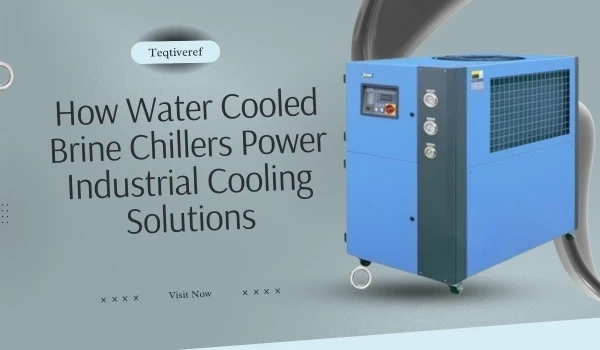Efficient and reliable cooling is the backbone of many industries. From chemical processing to pharmaceuticals, the right temperature control system ensures smooth production, product quality, and safety. Among the various technologies available, Water Cooled Brine Chiller have become a trusted choice for industries that demand consistent, low-temperature cooling.
But what exactly are brine chillers? How do they work, and why are they preferred in heavy-duty industrial applications? Let’s dive into the details.
What is a Water Cooled Brine Chiller?
A Water Cooled Brine Chiller is a specialized type of refrigeration equipment that uses brine solution (saltwater or glycol-water mixture) as the secondary refrigerant. The brine solution circulates through the system to absorb and transfer heat, delivering cooling where it is needed.
Unlike air-cooled systems, a Water Cooled Chiller removes heat using water and a cooling tower, which makes the system more energy-efficient and reliable for continuous operation.
Why Use Brine in Chillers?
Brine is essentially a mixture of water and salts (or glycol) that lowers the freezing point of the cooling fluid. This makes Water Cooled Brine Chillers suitable for processes that require sub-zero or ultra-low temperatures.
Key reasons industries use brine chillers:
- Sub-zero cooling capacity – Achieve temperatures much lower than pure water can handle.
- Non-freezing operation – Brine prevents ice formation, protecting equipment and pipelines.
- Stable performance – Offers consistent cooling for critical processes.
- Corrosion resistance – Special formulations protect system components and extend life.
Benefits of Water Cooled Brine Chillers
Installing a Water Cooled Brine Chiller brings numerous operational advantages.
1. Ultra-Low Temperature Performance
Where other chillers fail, brine chillers excel. Industries that need cooling below 0°C rely on brine to maintain safe and efficient operations.
2. High Energy Efficiency
Because heat is transferred using water rather than air, Water Cooled Chillers operate with lower power consumption. The addition of brine makes them even more efficient for low-temperature applications.
3. Durability and Reliability
Water Cooled Brine Chillers are built for demanding industrial conditions. They can handle continuous operation without performance drops, ensuring uninterrupted production.
4. Cost-Effective Operation
Although initial setup may require investment, these chillers save money in the long run by reducing downtime, maintenance costs, and energy consumption.
5. Versatility in Applications
From food processing to pharmaceuticals, brine chillers adapt to a wide variety of industrial requirements.
Industrial Applications of Water Cooled Brine Chillers
The adaptability of Water Cooled Brine Chillers makes them a go-to solution across industries:
- Food & Beverage Processing
- Used for blast freezing, cold storage, and beverage cooling, ensuring products maintain freshness and quality.
- Pharmaceutical Industry
- Many medicines and vaccines must be stored or processed at very low temperatures. Brine chillers provide reliable cooling for labs and manufacturing units.
- Chemical Industry
- Chemical reactions often generate extreme heat or require sub-zero cooling for stability. Water Cooled Screw Chillers with brine ensure accurate control.
- Ice Production Plants
- Brine chillers are widely used in the ice-making industry, from packaged ice cubes to large ice blocks.
- Industrial Process Cooling
- Any industry that demands consistent sub-zero cooling—metals, plastics, or textiles—benefits from Water Cooled Brine Chillers.
Water Cooled Brine Chillers vs. Glycol Chillers
Many businesses compare Water Cooled Brine Chillers with Water Cooled Glycol Chiller before deciding which to install. While they share similarities, each has unique strengths:
- Brine Chillers: Best suited for ultra-low temperature processes where freezing protection is essential.
- Glycol Chillers: Preferred for stable, corrosion-resistant performance in applications where moderate sub-zero cooling is required.
- Water Cooled Screw Chillers: Available in both brine and glycol designs, offering powerful and energy-efficient cooling for heavy-duty industries.
Efficiency and Sustainability
Modern industries care not only about performance but also about sustainability. Today’s Water Cooled Chillers are designed to use eco-friendly refrigerants and energy-efficient components.
Efficiency factors include:
- Optimized compressors that reduce energy consumption.
- Advanced control systems for precise temperature regulation.
- Use of green refrigerants that comply with international environmental standards.
- Longer life cycles with reduced maintenance needs.
These factors make Water Cooled Brine Chillers a smart investment for businesses that want reliable cooling while minimizing their environmental impact.
Final Thoughts
Cooling technology has evolved, but the need for consistent, low-temperature solutions remains the same across industries. A Water Cooled Brine Chiller offers unmatched efficiency, durability, and performance for sectors where sub-zero cooling is non-negotiable.
Whether you’re in food processing, pharmaceuticals, chemicals, or ice production, these chillers deliver stable and energy-efficient results. By combining the power of water cooling with the unique benefits of brine, industries get a solution that’s built to last and ready to meet future challenges.
If your goal is to improve process reliability, reduce energy costs, and achieve precise temperature control, then a Water Cooled Brine Chiller could be the perfect fit for your industrial needs.


